Epidemiology of suicide
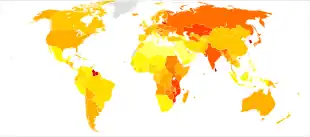
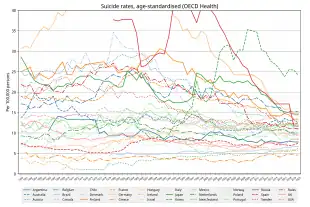

An estimated 1 million people worldwide die by suicide every year. Globally, suicide ranks among the three leading causes of death among those aged 15–44 years. Attempted suicides are up to 20 times more frequent than completed ones.
Incidence of suicide in a society depends on a range of factors. Clinical depression is an especially common cause. Bullying, which includes body shaming, can also drive people to suicide, as it increases social isolation.[2] Substance abuse and severe physical disease or infirmity are also recognized as causes. The Eastern Europe and East Asia regions have the highest suicide rate worldwide. The region with the lowest suicide rate is the Caribbean, followed by the Middle East.
Differences in suicide rates between genders are prominent, with males committing suicide at a higher rate in almost every country in the world.[3] However, females of all age groups tend to show higher rates of reported nonfatal suicidal behaviors.
Overview
In most countries the incidence of suicides is higher than the incidence of intentional homicides. More people die of suicide than die of war and murder.[4]
A 2006 report by the World Health Organization (WHO) states that nearly a million people take their own lives every year, more than those murdered or killed in war.[5] WHO figures show a suicide takes place somewhere in the world roughly every 40 seconds.[6]
According to the National Institute of Mental Health, suicide contagion is a serious problem, especially for young people. Suicide can be facilitated in vulnerable teens by exposure to real or fictional accounts of suicide, including media coverage of suicide, such as intensive reporting of the suicide of a celebrity or idol.[7]
By country

Suicide rates are highest in Europe's Baltic states, where around 40 people per 100,000 die by suicide each year. The lowest rates are found mainly in Caribbean/West Indies nations and a few countries in Asia.[6]
More than 30,000 people commit suicide in Russia every year;[9] more than 40,000 people die by suicide each year in the United States;[10] over 30,000 kill themselves in Japan;[11] and about 250,000 commit suicide each year in China.[12] In western countries men commit suicide at four times the rate of women. Women are more likely to attempt suicide than men.[13]
The countries of the former Soviet Bloc have the highest suicide rate in the world. Rate of suicide in South Korea is the highest among any other East Asian countries. The region with the lowest suicide rate is Latin America.[14]
China is the only country in the world where the rate of suicide by women matches that of men, with statistics even showing a slightly higher number of female cases.[15]
Between 1999-2006, in the United States, suicide was the third leading cause of death in adolescents aged 15 to 19 years, and the fourth leading cause of death for children aged 10 to 14 years.[16] As of 2011, suicide increased in this age group, becoming the second cause of death for youth between the ages of 15 and 24 years, below homicide statistics and above those of accidents.[17] Geographically within the United States, western states have higher rates of suicide. Per 100,000 people, Montana is ranked first, Alaska ranked second, and Wyoming is third.[18] There may be a link between these states and firearm regulations, which make access to guns easier, as statistics show firearm suicides in states with the highest rates of gun ownership are 3.7 times higher for men, and 7.9 times higher for women.[19] These are often rural areas without heavily populated urban communities (which brings social pressure stressors), but may indicate a lack of accessibility to medical and psychological health assistance in these remote areas.[20][21]
Sex
.svg.png.webp)
.svg.png.webp)
|
0 - 5
5 - 10
|
10 - 15
15 - 25
|
25 - 35
Above 35
|
No data
|
In the United States, males are four times more likely to die by suicide than females, although more women than men report suicide attempts and self-harm with suicidal intentions. Male suicide rates are far higher than females in all age groups (the ratio varies from 3:1 to 10:1). In other western countries, males are also much more likely to die by suicide than females (usually by a factor of 3–4:1). It was the 8th leading cause of death for males, and 19th leading cause of death for females.[22]
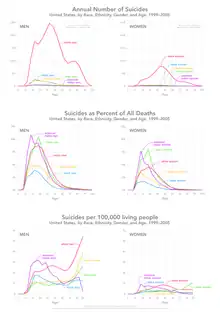
Excess male mortality from suicide is lower in non-Western where as of 2015 in China (about one fifth of world population) and seven more countries it is absent, with females more likely to die by suicide than males by a factor of 1.3–1.6[24][25]
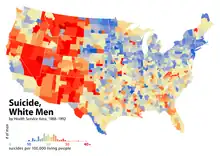
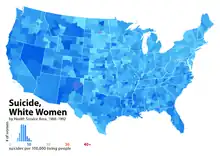
Race and sexual orientation
In 2003, in the United States, whites and Asians were nearly 2.5 times more likely to kill themselves than were blacks or Hispanics.[26] In the eastern portion of the world (primarily in Asian or Pacific-Island countries) the numbers of reported suicides is growing every year.[27]
The likelihood of suicide attempts are increased in both gay males and lesbians, as well as bisexuals of both sexes when compared to their heterosexual counterparts.[28][29][30] The trend of having a higher incident rate among females is no exception with lesbians or bisexual females and when compared with homosexual males, lesbians are more likely to attempt than gay or bisexual males.[31]
Studies vary with just how increased the risk is compared to heterosexuals with a low of 0.8-1.1 times more likely for females[32] and 1.5-2.5 times more likely for males.[33][34] The highs reach 4.6 more likely in females[35] and 14.6 more likely in males.[36]
Race and age play a factor in the increased risk. The highest ratios for males are attributed to caucasians when they are in their youth. By the age of 25, their risk is down to less than half of what it was, however black gay males' risk steadily increases to 8.6 times more likely. Through a lifetime the risks are 5.7 for white and 12.8 for black gay and bisexual males.[36]
Lesbian and bisexual females have opposite effects with less attempts in youth when compared to heterosexual females. Through a lifetime the likelihood to attempt nearly triple the youth 1.1 ratio for caucasian females, however for black females the rate is affected very little (less than 0.1 to 0.3 difference) with heterosexual black females having a slightly higher risk throughout most of the age-based study.[36]
Gay and lesbian youth who attempt suicide are disproportionately subject to anti-gay attitudes, and have weaker skills for coping with discrimination, isolation, and loneliness,[36][37] and were more likely to experience family rejection[38] than those who do not attempt suicide. Another study found that gay and bisexual youth who attempted suicide had more feminine gender roles,[39] adopted an LGB identity at a young age and were more likely than peers to report sexual abuse, drug abuse, and arrests for misconduct.[39]
One study found that same-sex sexual behavior, but not homosexual attraction or homosexual identity, was significantly predictive of suicide among Norwegian adolescents.[40] In Denmark, the age-adjusted suicide mortality risk for men in registered domestic partnerships was nearly eight times greater than for men with positive histories of heterosexual marriage and nearly twice as high for men who had never married.[41]
A study of suicide, undertaken in Sweden, involved the analysis of data records for 6,456 same-sex married couples and 1,181,723 man-women marriages. Even with Sweden's tolerant attitude regarding homosexuality, it was determined that for same-sex married men the suicide risk was nearly three times higher than for different-sex married men, even after an adjustment for HIV status. For women, it was shown that there was a tentatively elevated suicide risk for same-sex married women over that of different-sex married women.[42]
Religion
Compared with other countries, atheist states, such as the People's Republic of China, have the highest suicide rate (25.6 per 100,000 persons).[43]
In a global study on atheism, sociologist Phil Zuckerman noted countries with higher levels of atheism had the highest suicide rates compared to countries with "statistically insignificant levels of organic atheism."[44]
Social factors
Higher levels of social and national cohesion reduce suicide rates. Suicide levels are highest among the retired, unemployed, impoverished, divorced, the childless, urbanites, empty nesters, and other people who live alone. Suicide rates also rise during times of economic uncertainty. (Although poverty is not a direct cause, it can contribute to the risk of suicide).[45]
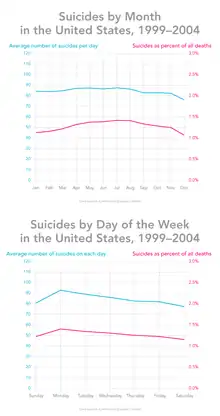
Epidemiological studies generally show a relationship between suicide or suicidal behaviors and socio-economic disadvantage, including limited educational achievement, homelessness, unemployment, economic dependence, and contact with the police or justice system.[45] War is traditionally believed to be associated with a fall in suicide rates; however, this has been questioned in recent studies, showing a more complex picture than previously conceived.[46][47]
A 2015 UK study by the Office for National Statistics, commissioned by Public Health England, which considered 18,998 deaths of people aged between 20 and 64, found that men working in the construction industry and women employed in culture, media and sport, healthcare and primary school teaching were at the highest risk of suicide.[48]
Health
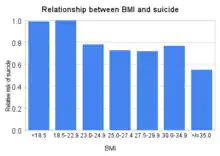
Depression, either unipolar or as part of bipolar disorder, is an especially common cause. Substance abuse, severe physical disease or infirmity are also recognized causes.
An unknown number of suicidal fatalities are falsely presumed to be the consequences of severe illnesses, infectious, malignant, mental et cetera.
Body mass index
Risk of suicide may decrease with increased weight and is low in obese persons.[49] The connection is not well understood, but it is hypothesized that elevated body weight results in higher circulating levels of tryptophan, serotonin, and leptin, which in turn reduces impulsivity.[50]
However, other studies indicate that suicide rates increase with extreme obesity, and it is difficult to control for conflating factors such as BMI-related differences in longevity, which have a significant bearing on suicide rates.[51]
Season
The idea that suicide is more common during the winter holidays (including Christmas in the northern hemisphere) is actually a myth, generally reinforced by media coverage associating suicide with the holiday season. The National Center for Health Statistics found that suicides drop during the winter months, and peak during spring and early summer.[52][53] Considering that there is a correlation between the winter season and rates of depression,[54] there are theories that this might be accounted for by capability to commit suicide and relative cheerfulness.[55] Suicide has also been linked to other seasonal factors.[56]
The variation in suicides by day of week is actually greater than any seasonal variation.[57]
Trends
Certain time trends can be related to the type of death. In the United Kingdom, for example, the steady rise in suicides from 1945 to 1963 was probably to some extent curtailed following the removal of carbon monoxide from domestic gas supplies which occurred with the change from coal gas to natural gas during the sixties.[58] Methods vary across cultures, and the easy availability of lethal agents and materials plays a role.
It is estimated that global annual suicide fatalities could rise to 1.5 million by 2020. Worldwide, suicide ranks among the three leading causes of death among those aged 15–44 years. Suicide attempts are up to 20 times more frequent than completed suicides.[59]
Historical trends
Historical data show lower suicide rates during periods of war.[60][61][62]
See also
- Copycat suicide
- Suicide epidemic
References
- ↑ Data from Global Health Observatory Data Repository - Suicide rates Data by country (2012)
- ↑ "Suicide Fact Sheet". World Health Organization. Retrieved 3 December 2020.
- ↑ "Suicide Rate Estimates". World Health Organization. Retrieved 3 December 2020.
- ↑ "World Suicide Prevention Day is marked". Raidió Teilifís Éireann. 10 September 2004. Retrieved 11 June 2012.
- ↑ "Suicide prevention". WHO Sites: Mental Health. World Health Organization. February 16, 2006. Archived from the original on July 1, 2004. Retrieved 2006-04-11.
- 1 2 Staff (2002). "Self-directed violence" (PDF). World Health Organization. Retrieved 2006-04-11.
- ↑ Staff (December 1999). "Frequently Asked Questions about Suicide". NIMH: Suicide Prevention. National Institute of Mental Health (United States). Archived from the original on 2006-03-08. Retrieved 2006-04-11.
- ↑ "Share of deaths from suicide". Our World in Data. Retrieved 4 March 2020.
- ↑ "Suicide in Japan". Nippon.com. 9 October 2014. Archived from the original on 13 August 2019. Retrieved 13 August 2019.
- ↑ "Deaths From Drugs and Suicide Reach a Record in the U.S." The New York Times. March 7, 2019.
- ↑ "Suicides in Japan top 30,000 for 9th straight year". Yahoo!. Archived from the original on 2007-09-05.
- ↑ 250,000 Chinese Kill Themselves Annually: Official
- ↑ "The Numbers Count: Mental Disorders in America — Suicide". National Institute of Mental Health. Archived from the original on 2007-10-22. Retrieved 2007-12-11.
- ↑ "BBC NEWS - In Depth - More killed by suicide than war". bc.co.uk. 2004-09-08. Retrieved 19 March 2017.
- ↑ Joiner, Thomas (30 September 2007). Why People Die by Suicide. Harvard University Press. ISBN 9780674039209. Retrieved 19 March 2017 – via Google Books.
- ↑ Spirito, A., Overholser, J. (2003). Evaluating and treating adolescent suicide attempters: From research to practice (Practical resources for the mental health professional). Amsterdam: Academic Press, p. 1.
- ↑ American Association of Suicidology. (2011). National suicide statistics: 2011 Data - Rates, numbers, and rankings of each state. Retrieved from http://www.suicidology.org/resources/facts-statistics Archived 2017-06-06 at the Wayback Machine
- ↑ Drapeau, C. W. & McIntosh, J. L., for American Association of Suicidology. (2015, January 22). U.S.A. suicide: 2013 Official final data. Retrieved from http://opi.mt.gov/pdf/Health/SuicideAware/13US_SuicideRates.pdf Archived 2017-05-26 at the Wayback Machine
- ↑ Drexler, M. (2017). Guns and suicide: The hidden toll. Harvard Public Health. Retrieved from https://www.hsph.harvard.edu/magazine/magazine_article/guns-suicide/
- ↑ Clay, R. A. (2014). "Reducing rural suicide". APA Monitor. 45 (4): 36.
- ↑ Cross, T. L. (2013). Suicide among gifted children and adolescents: Understanding the suicidal mind. Waco, TX: Prufrock Press.
- ↑ "Teen Suicide Statistics". Adolescent Teenage Suicide Prevention. FamilyFirstAid.org. 2001. Retrieved 2006-04-11.
- 1 2 "Referral Page - N C H S - Data Warehouse". cdc.gov. Retrieved 19 March 2017.
- ↑ Jodi O'Brien (Editor) (2009). Encyclopedia of Gender and Society (p. 817). SAGE Publications. ISBN 9781452266022.
{{cite book}}:|author=has generic name (help) - ↑ "Suicide rates, crude - Data by country". WHO. 2018-04-05.
- ↑ Hoyert, Donna; Heron, Melonie P.; Murphy, Sherry L.; Kung, Hsiang-Ching (2006-04-19). "Deaths: Final Data for 2003" (PDF). National Vital Statistics Report. 54 (13): 1–120. PMID 16689256. Retrieved 2006-07-22.
- ↑ "Epidemiology of Suicide", Behind Asia's Epidemic, Marten Publications, 2008
- ↑ Westefeld, John; Maples, Michael; Buford, Brian; Taylor, Steve (2001). "Gay, Lesbian, and Bisexual College Students". Journal of College Student Psychotherapy. 15 (3): 71–82. doi:10.1300/J035v15n03_06. S2CID 145338147.
- ↑ Fergusson DM, Horwood LJ, Ridder EM, Beautrais AL (July 2005). "Sexual orientation and mental health in a birth cohort of young adults". Psychological Medicine. 35 (7): 971–81. doi:10.1017/S0033291704004222. hdl:10523/10291. PMID 16045064.
- ↑ Silenzio VM, Pena JB, Duberstein PR, Cerel J, Knox KL (November 2007). "Sexual Orientation and Risk Factors for Suicidal Ideation and Suicide Attempts Among Adolescents and Young Adults". American Journal of Public Health. 97 (11): 2017–9. doi:10.2105/AJPH.2006.095943. PMC 2040383. PMID 17901445.
- ↑ Gay, Lesbian, Bisexual & Transgender "Attempted Suicide" Incidences/Risks Suicidality Studies From 1970 to 2009
- ↑ Bell & Weinberg (1978): Tables 21.14 & 21.15, pages 453-454.
- ↑ Safren SA, Heimberg RG (December 1999). "Depression, hopelessness, suicidality, and related factors in sexual minority and heterosexual adolescents". Journal of Consulting and Clinical Psychology. 67 (6): 859–66. doi:10.1037/0022-006X.67.6.859. PMID 10596508.
- ↑ Russell ST, Joyner K (August 2001). "Adolescent Sexual Orientation and Suicide Risk: Evidence From a National Study". American Journal of Public Health. 91 (8): 1276–81. doi:10.2105/AJPH.91.8.1276. PMC 1446760. PMID 11499118.
- ↑ Saghir MT, Robins E, Walbran B, Gentry KA (August 1970). "Homosexuality. IV. Psychiatric disorders and disability in the female homosexual". The American Journal of Psychiatry. 127 (2): 147–54. doi:10.1176/ajp.127.2.147. PMID 5473144.
- 1 2 3 4 ed. Sandfort, T; et al. Lesbian and Gay Studies: An Introductory, Interdisciplinary Approach. Chapter 2.
- ↑ Rotheram-Boris, et al. (1994); Proctor and Groze (1994)
- ↑ Ryan C, Huebner D, Diaz RM, Sanchez J (January 2009). "Family rejection as a predictor of negative health outcomes in white and Latino lesbian, gay, and bisexual young adults". Pediatrics. 123 (1): 346–52. doi:10.1542/peds.2007-3524. PMID 19117902. S2CID 33361972.
- 1 2 Remafedi G, Farrow JA, Deisher RW (June 1991). "Risk factors for attempted suicide in gay and bisexual youth". Pediatrics. 87 (6): 869–75. PMID 2034492.
- ↑ Wichstrøm L, Hegna K (February 2003). "Sexual orientation and suicide attempt: a longitudinal study of the general Norwegian adolescent population". Journal of Abnormal Psychology. 112 (1): 144–51. doi:10.1037/0021-843X.112.1.144. PMID 12653422.
- ↑ Mathy RM, Cochran SD, Olsen J, Mays VM (December 2009). "The association between relationship markers of sexual orientation and suicide: Denmark, 1990–2001". Soc Psychiatry Psychiatr Epidemiol. 46 (2): 111–7. doi:10.1007/s00127-009-0177-3. PMC 3034881. PMID 20033129.
- ↑ Björkenstam, Charlotte; et al. (11 May 2016). "Suicide in married couples in Sweden: Is the risk greater in same-sex couples". European Journal of Epidemiology. 31 (7): 685–690. doi:10.1007/s10654-016-0154-6. PMC 6889060. PMID 27168192.
- ↑ Bertolote, Jose Manoel; Fleischmann, Alexandra (2002). "A Global Perspective in the Epidemiology of Suicide" (PDF). Suicidologi. 7 (2): 7–8. Archived from the original (PDF) on 2021-01-18. Retrieved 2020-06-26.
In Muslim countries (e.g. Kuwait), where committing suicide is most strictly forbidden, the total suicide rate is close to zero (0.1 per 100,000 population). In Hindu (e.g. India) and Christian countries (e.g. Italy), the total suicide rate is around 10 per 100,000 (Hindu: 9.6; Christian: 11.2). In Buddhist countries (e.g. Japan), the total suicide rate is distinctly higher at 17.9 per 100,000 population. At 25.6, the total suicide rate is markedly highest in Atheist countries (e.g. China) which included in this analysis countries where religious observances had been prohibited for a long period of time (e.g. Albania).
- ↑ Zuckerman, Phil (2007). Martin, Michael (ed.). The Cambridge Companion to Atheism. Cambridge Univ. Press. pp. 58–59. ISBN 978-0521603676.
Concerning suicide rates, religious nations fare better than secular nations. According to the 2003 World Health Organization’s report on international male suicides rates, of the top ten nations with the highest male suicide rates, all but one (Sri Lanka) are strongly irreligious nations with high levels of atheism. Of the top remaining nine nations leading the world in male suicide rates, all are former Soviet/Communist nations, such as Belarus, Ukraine, and Latvia. Of the bottom ten nations with the lowest male suicide rates, all are highly religious nations with statistically insignificant levels of organic atheism.
- 1 2 Diego De Leo & Russell Evans (Griffith University) (2003). "International Suicide Rates: Recent Trends and Implications for Australia" (PDF). Australian Institute for Suicide Research and Prevention. Archived from the original (PDF) on 24 August 2012. Retrieved 2008-08-29.
- ↑ Henderson, Rob (2006). "Changes in Scottish suicide rates during the Second World War". BMC Public Health. 6: 167. doi:10.1186/1471-2458-6-167. PMC 1526726. PMID 16796751.
- ↑ Bosnar, A. (2005). "Suicide and the war in Croatia". Forensic Science International. 147: S13–S16. doi:10.1016/j.forsciint.2004.09.086. PMID 15694719.
- ↑ Siddique, Haroon (17 March 2017). "Male construction workers at greatest risk of suicide, study finds". The Guardian. Retrieved 19 March 2017.
- 1 2 Mukamal KJ, Rimm EB, Kawachi I, O'Reilly EJ, Calle EE, Miller M (November 2009). "Body Mass Index and Risk of Suicide Among One Million US Adults". Epidemiology. 21 (1): 82–6. doi:10.1097/EDE.0b013e3181c1fa2d. PMID 19907331. S2CID 10646644.
- ↑ Ottar Bjerkeset; Pål Romundstad; Jonathan Evans; David Gunnell (2008). "Association of Adult Body Mass Index and Height with Anxiety, Depression, and Suicide in the General Population". Am. J. Epidemiol. 167 (2): 193–202. doi:10.1093/aje/kwm280. PMID 17981889.
- ↑ Wagner, B (2013). "Extreme obesity is associated with suicidal behavior and suicide attempts in adults: results of a population-based representative sample". Depression and Anxiety. 30 (10): 975–81. doi:10.1002/da.22105. PMID 23576272. S2CID 24319987.
- ↑ "Study: Suicides Drop During Holidays". NPR.org. Retrieved 19 March 2017.
- ↑ "Holiday Suicides: Fact or Myth-Suicide-Violence Prevention-Injury Center-CDC". 2017-01-25. Retrieved 19 March 2017.
- ↑ See Seasonal affective disorder
- ↑ "Suicide: Practice Essentials, Overview, Etiology". 28 October 2016. Retrieved 19 March 2017 – via eMedicine.
{{cite journal}}: Cite journal requires|journal=(help) - ↑ "BBC News - HEALTH - Suicide 'linked to' the moon". Retrieved 19 March 2017.
- ↑ NBC News article referencing a study published in Social Psychiatry and Psychiatric Epidemiology
- ↑ Kreitman, N. (1976). "The coal gas story. United Kingdom suicide rates, 1960-71". British Journal of Preventive and Social Medicine. 30 (2): 86–93. doi:10.1136/jech.30.2.86. JSTOR 25565893. PMC 478945. PMID 953381.
- ↑ Staff (February 16, 2006). "SUPRE". WHO sites: Mental Health. World Health Organization. Archived from the original on December 12, 2012. Retrieved 2006-04-11.
- ↑ Thomas, Kyla; Gunnell, David (1 December 2010). "Suicide in England and Wales 1861–2007: a time-trends analysis". Int J Epidemiol. 39 (6): 1464–1475. doi:10.1093/ije/dyq094. PMID 20519333. Retrieved 19 March 2017 – via ije.oxfordjournals.org.
- ↑ "BBC NEWS - Health - More suicides under Conservative rule". 2002-09-18. Retrieved 19 March 2017.
- ↑ "Suicide during the Second World War".